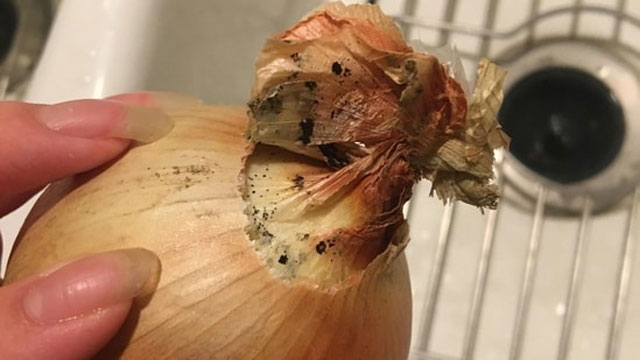Daijiworld Media Network - Bengaluru
Bengaluru, Oct 29: If you’ve ever noticed black spots or a sooty coating on onions and wondered whether they’re still safe to eat, you’re not alone. According to Bharathi Kumar, Nutritionist at Fortis Hospital, Nagarbhavi, Bengaluru, the answer depends on how deep the discoloration goes — and how the onion feels inside.
Speaking to HT Lifestyle, Bharathi explained that the black coating is usually caused by Aspergillus niger, a common environmental fungus that grows in warm, humid, and poorly ventilated storage conditions. “Onion skins covered with a dark, sooty layer are usually due to surface fungal growth,” she said, adding that while this is not the same as the deadly ‘black fungus’ infection, it can still pose a health risk if not handled properly.

How the fungus grows
The fungus typically infects onions when the outer skin is damaged or exposed to moisture during transport or storage. The black powdery spores make the onion appear as though it’s covered in charcoal dust.
While small amounts of the fungus are not immediately harmful, Bharathi warned that Aspergillus species can produce ochratoxin A, a toxin linked to kidney and liver damage when consumed over time. “This toxin can survive even moderate heat, so cooking may not destroy it,” she cautioned.
When to discard onions
Bharathi advised inspecting the onion carefully before use.
“If the black discoloration is limited to the dry outer skin and the inner layers are firm, crisp, and white, it’s generally safe to peel, rinse, and cook the onion. But if the black spots extend deeper or the onion feels soft, mushy, or smells foul, it’s best to discard it,” she said.
Who should be extra careful
People with weakened immunity, uncontrolled diabetes, chronic illnesses, or those on immunosuppressive medication should avoid eating any fruit or vegetable that appears mouldy or spoiled. “What may be safe for a healthy adult could be risky for them,” Bharathi warned.
Not the same as ‘Black Fungus’
Clarifying a common misconception, she said, “The black layer seen on onions has nothing to do with mucormycosis or the so-called ‘black fungus’ infection. The two are entirely different — one affects stored vegetables, the other affects internal human tissues under rare medical conditions.”
How to prevent it
Proper storage can greatly reduce the risk of fungal growth. Bharathi recommended keeping onions in a cool, dry, and well-ventilated area, away from sealed containers and moisture. “Moist, enclosed spaces allow fungal spores to multiply. Once the outer layers are damaged, decay spreads faster,” she noted.
She concluded by advising households and restaurants to check for firmness, dryness, and ventilation when purchasing onions. “A few simple precautions during buying and storage can prevent most of these issues before the onions even reach your kitchen,” she said.
Bottom line: If the black spots are only on the outer layers, peel and use after cleaning. But if the onion looks soft, smells off, or shows deep fungal growth — it’s safer to throw it away.